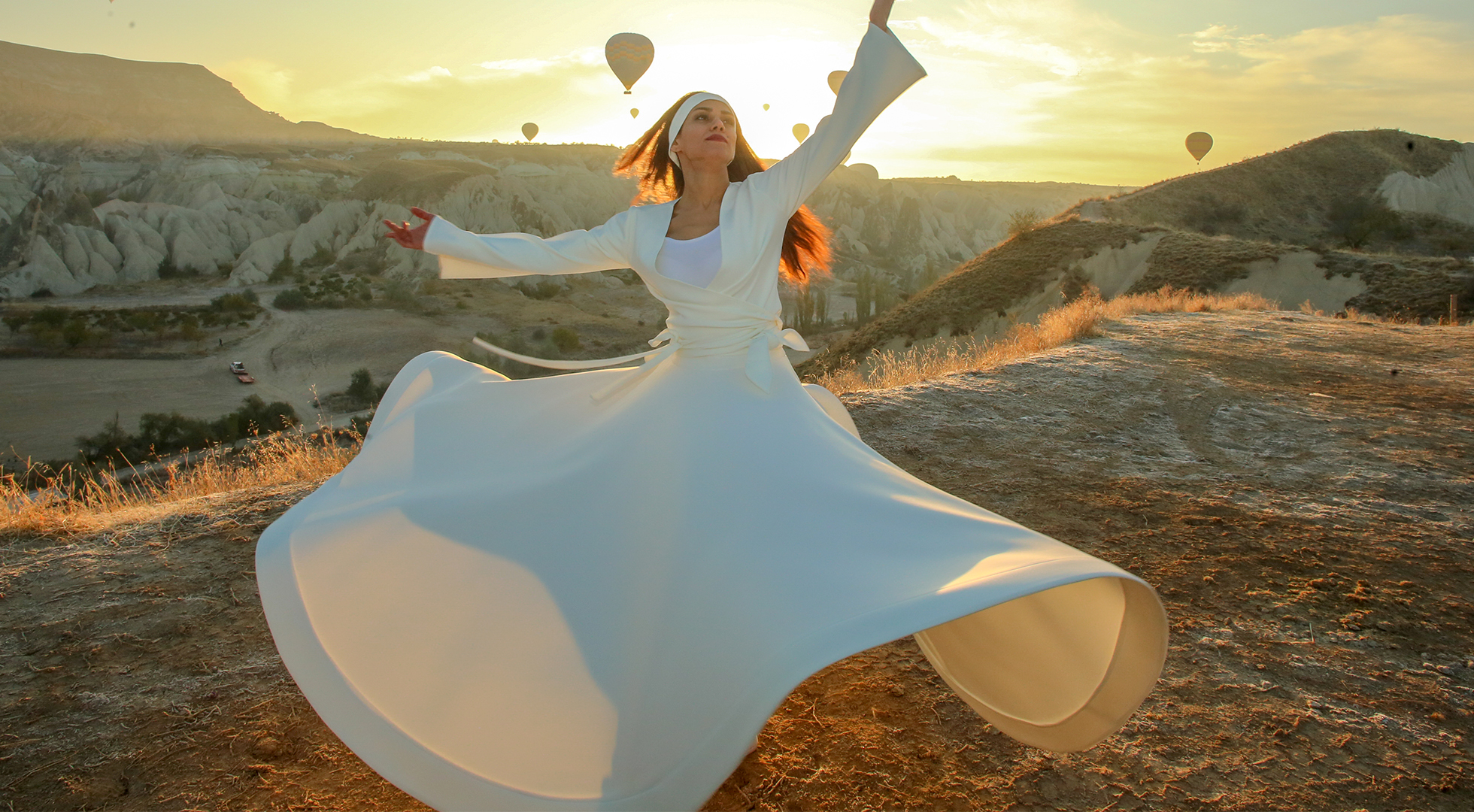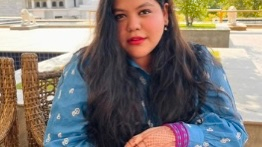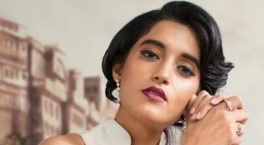“The women of my country are in the urgent need of embracing an art like dance.” - Khatoon Fallah
In conversation with Khatoon Fallah, mystical contemporary Persian dancer, performer and master.
1) Tell us about yourself. How did you discover the path of mystical dance?
I come from a place where dancing is considered disorderly for women. A country (Iran) where, when I look at its ancient history, I see people having celebrations in all of the twelve months of the year for different reasons and occasions; a country where being sad would be seen as a sin; a country where joining in celebration was a necessity.
On a summer night, back in 2009, we were spending the night on the beach of the Caspian Sea where a girl whom I had met for the first time, started dancing. Her hands were opened towards the sky and they came back to her heart. How sensational! Her dance touched my heart!
“What kind of a dance is this? How could you perform it with that much emotion and love? How and from where can I learn it?” I asked Farshideh, the dancing girl. After that night, and let’s not forget that I was a twenty-nine-year-old woman at that time with no academic dance education who was working every day from nine a.m. until six p.m., I got guided to take an underground dance class in Iran. I spent five years learning the alphabets of dance from my teacher, Mansoureh Alimadadi. I gained some theatrical experience in those years as well. After that I started teaching dance just how my teacher did, as an underground activity.
After a while, I became familiar with whirling. Because I had learned how to turn in dancing and I knew the turns well, I could be whirling really fast so that I drew eyes to myself with my whirling.
Here, I can make an honest confession that I was just turning without knowing the actual reason, the secret and the concept behind this act. I did not even know why the Dervishes whirled.
This way, I encountered the larger world of dance suddenly and then I realized that I know absolutely nothing about dance.

2) What inspired you to adapt to dance? Tell us more about Dastan and Kadin.
I felt the need for using dance as a means to express myself. First night that I rehearsed the sequence that my teacher had taught me. I remember very well how teardrops ran down my cheeks as I was looking at my body and my hands in the mirror and the way they moved in the air. What’s this that is merged with my being? As if a woman were dormant inside me for years or maybe it was perishing, and when I heard that, the sound of my dance on the seashore on that summer night, she was resuscitated. Possibly taking her last gasps of breath, she was revived, and she’s been keeping me alive ever since. It’s her who surprises me with her innovation every moment on the stage or in the class.
My definition of dance? Dancing is my prayer.
Dastan was my first playlet whose idea was evolved during my training through class work (In Persian, the word “Dastan” literally means the “the hands”, which is the plural form for the word “Dast”, meaning “a hand”).
Dastan is the story of a battle of gods and servants over the good and the evil. A battle between the hands, a battle to the last drop of blood. An endless, infinite battle, from infinity to eternity.
Dastan was a theatrical play, (My theatrical child!) which granted me a public performance. This time it was performed on the ground, not underground! And that was where I showed my theatrical proficiency. A radical body that roared on the stage to demand her share from the stage that belonged to her.
Speaking of Kadin, in Turkish it literally means “a woman”. I gave it a Turkish name after my immigration to Turkey coincided with the date of its performance.
Kadin is the story of women from the East. It’s about the death of a woman and her best efforts to revive herself.
The Eastern woman reveals herself after years of repressed screams. After this performance, I had an interview with the cultural column of the Turkish famous newspaper, Hurriyet, where I explained the reason behind my immigration. I stated that it’s time that the machine of cruelty and injustice against women should be stopped. Unfortunately, in countries such as Turkey, Afghanistan, Pakistan, Iran, etc., child marriage is still a common occurrence.
3) Tell us about the traditional ritual aspect of Dance. How can you relate it with a healthy mind, soul and body?
I’m talking about Sama, the mystic dance practiced by the mystics of Sufism. This type of dance is like a real meditation. In this rotative dance, which looks quite simple, the mind concentrates on the current moment, neither on the past, nor on the future. One’s mind is completely present in the moment. One of the causes for one’s mental anxiety is the constant overthinking about the past and one’s concerns about the future. Of course, people crave peace, and the outer environment, teeming with diseases and conflicts, harms their mental health.
My experience of the Sama dance is inexplicable in words.
After Sama dance workshops there are beautiful scene of students and trainees, full of love and happiness, embracing each other as if they have known one another for years. Body and soul are in a state of peaceful coexistence in such religious dances. The body gives the soul what it needs: enthusiasm, delight, joy, and love.

4) Tell us about Kimia and the gypsy girl.
Kimia Khatoon is the wife of Shams Tabrizi, who is famous for inspiring and instructing Rumi and changing the course of his life. This piece of Persian dance theatre displays the magnificent life of Kimia in seven acts. There are different stories of her life narrated in historical books. Some believe she fell in love with Shams. To be honest, I believe this story too, because Shams had been able to impress Rumi, the great scholar of Konya at that era, and it’s not improbable that Kimia had fallen in love with him too … but this love brought about much pain for Kimia.
Rumi says: “Pain is the leader of the human being.” In my story, Kimia reaches a much greater love which connects the earth to the sky and leaves behind a physical, mundane love. The story of this female mystic has been lost and unappreciated throughout history, because everyone’s busy with the story of Rumi and Shams, the iconic figures in Islamic mysticism (Sufism). In January 2020, I performed it on the stage of the Asia and Pacific museum in Warsaw and I had another performance in the Goldbekhaus hall in Hamburg, Germany, but unfortunately it didn’t go ahead due to the Covid-19 pandemic and the restrictions on public performances.
Gypsy Girl is a training course which was programmed in 15 sessions and organized online for Iranians in Persia. Tons of people from across the country took part in this course and it was extended to 3 courses as a result! As much as I know, it was the first Iranian theatre-dance course which had occurred in the form of play. Every chapter of Gypsy Girl was a combination of a short dance and at the start of every session we narrated the story.
The women of my country are in the urgent need of embracing an art like dance. I saw beautiful souls in this course who had forgotten their femininity. Holding the hands of each other on the social media, these women strongly support each other these days and do non-dancing activities together. Seems like a miracle has happened. Yes, that’s the miracle of love.

5) We would like to know about your experience with beauty and beauty rituals growing up in Iran and Turkey.
To answer this question completely, I would like to introduce some Iranian rituals to you:
Chahar Shanbeh Sori or Fire Festival
In ancient times Chahar Shanbeh Sori was celebrated on the night of the last Wednesday of winter. People believed that the souls of their ancestors would come back to earth under the cover of darkness, to visit them on this special night. To help guide the souls to earth, the people would start a number of small fires on their rooftops or in their yard. Each fire was started with a taper lit from the main fire in their homes.
Little by little, this ancient ceremony got changed and people started to set a fire for welcoming the spring; this fire world normally keep burning till the sunrise or the morning of the day ahead.
These days, Iranian people from all cities, would gather together with empathy and kindness on this very special night. There is a famous sentence which is heard on this night and that is: “my yellowness is from you; your redness is from me”. Iranians say this to the fire, they jump over it and by saying that sentence they mean they want the fire to take all their paleness, sicknesses and problems away and instead, bring them redness, warmth, and power.
Sizdah be Dar
Another traditional ceremony which I would like to tell you about is Sizdah be Dar - The Iranians have a tradition of spending the day outdoors on the thirteenth day of the Persian new year (Norouz).
They believe that the first twelve days of the year are very important, because they symbolize order in the world and in the lives of people. The thirteenth day marks the beginning of the return to ordinary daily life.
It is customary on this day, for families to pack a picnic basket and go to a park or countryside.
Another custom performed on this day is that young single ladies tie the grass hoping and wishing for finding their beloved one, to find a spouse. To tie the grass is a reminiscent of the male and female bond.
In Turkey, where I live, is a beauty ritual which you can also see in Iran, called Henna; a really beautiful ritual. It has an interesting meaning behind it: It is believed by many Muslims that by rubbing henna to things is like bequeathing those things. For instance, they used to put henna on the heads of the soldiers which meant that they are dedicated to their country. In Turkey, in this Henna ceremony, they rub henna on the hands of the groom and bride meaning that they belong to each other forever. They also put a piece of a precious red fabric as a symbol of immaculacy. Music will be played, and the bride will sometimes cry. They say that the more the bride cries, the happier she will be in her new life. While she is crying, the groom’s mother puts a coin in her hand so that their house is blessed.
I have been invited to this ceremony many times in Turkey and I have put that piece of red fabric on the head of the bride. This ceremony is usually held in Iran as well but not in such a beautiful way.

6) Could you tell us a few traditional beauty rituals you learned from members of your family while growing up?
Before answering this question, I’d like to give you a brief idea of the history of make-up and cosmetics in ancient Iran. Parts of the ancient world discovered in modern-day south-west Iran show that in 2000 BC Iranian women reddened their lips and cheeks and made their eyes look larger thanks to the art of make-up. After thousands of years and the mass conversion of Iranians to Islam, nowadays Iranian Muslims wear nice clothes and perfume before worshipping God, but in traditional Iranian culture, cosmetics were frowned upon, except for married women. For example, plucking eyebrows for young ladies was a sign of being married, but nowadays Iranian young girls and women wear make-up before showing up in public. Currently Iran is one of the countries with the highest cosmetics consumption per capita, which is 2.5 times higher than the global average consumption. In Ancient Iran, there used to be a ritual called Haft Ghalam Arayesh (literally means seven types of cosmetics), where women used 7 different types of cosmetics, which also served therapeutic purposes, the most common of which was Henna, which was used for hair coloring in addition to being anti-fungal.
Another popular cosmetic, named Kohl, was not only used for blackening the eyes and making them look bigger, but also for controlling humidity and the treatment of eyelash loss.
Another famous cosmetic is called Ghaliyeh, which was largely used for hair dying thanks to its dark color, used for clearing freckles and acne off the face.
Another one, which is still used by our grandmothers in bath, is called Sefidab (Venetian Ceruse) and is used as a skin whitener and a natural layer remover of the skin. I personally used it years ago, because my mom would use it.
7) Tell us about your skin care regime.
Due to many sport activities that I do every day, I drink a lot of water. Naturally, this helps my body detoxify. I have also been using sunscreen for years. Another product I use daily for my skin is an anti-wrinkle cream. In fact, I have oily skin and I feel that I may need more skin care.

8) Tell us about the women that inspire you.
I remember Mansoureh Alimadadi, who was my first ever dance instructor, as a strong person in terms of personality. She was a confident and energetic woman, and a creative teacher who taught me the alphabets of dancing. Another person who inspired me deeply was Shahrzad Khorsandi. She was one of my teachers as well. Primarily, she was and still is the teacher of ethics to me; a woman who embraced me humbly and with all sincerity in the path of dance and nourished me with all her knowledge.
She is generous in teaching dance to others. I had the chance of being her student and also had a performance with her on the stage which is one of the honors of my career.
Miriam Peretz, whose heart keeps such mysticism in itself that radiates to all who come near to her, was another source of inspiration for me whom I had the opportunity to live with for almost a week in Turkey.

9) What is your definition of beauty and self-care?
For self-care, daily exercise has helped me both physically and mentally. Also, I adore walking and I really enjoy doing it.
Moreover, being organized is very important to me. I even have a notebook/personal calendar that helps me in writing down all the things I should do, like my responsibilities or my upcoming meetings and so much things else.
My definition of beauty is that moment when you feel alive with all your being. I found the living and creative manifestation of Khatoon in dancing.
Khatoon wants her clothes to be beautiful, her room to be beautiful. She enjoys the beauty of nature and also, she loves to create beauty. The point of art is also to create this beauty. Real beauty is the something that stays the same even as time passes.












1 how
So proud of you my dear master….
Such a great Wisdom that keeps shining in my heart, I learned from u how can I live and dance,
I was lost and I found my way, in leak of confidence, I found my confidence with your lessons. I thank God everyday for your presence in my life 💛